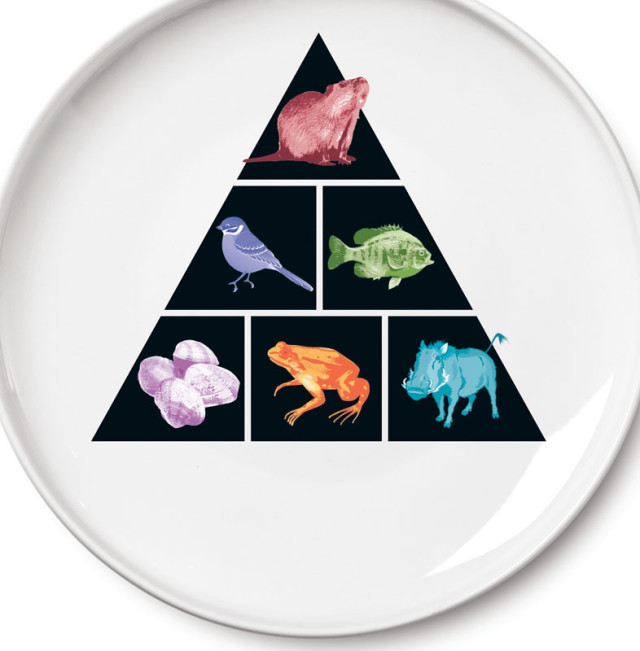The Joy of Cooking Invasive Species

Image: Nomad
Slogging across the damp flats of Siletz Bay at low tide, Tamara Mullen scans the sand for air holes. She finds a congregation of little cavities, about as wide as pencils, and starts digging. The pit instantly fills with seawater. Dropping to her hands and knees, she gropes in the cold brine for her prey: the purple varnish clam. This mussel is mild-tasting, plentiful—and an alien intruder taking over the bay.
Native to Japan and Korea, purple varnishes arrived here thanks to freighter ships dumping ballast water. They are among hundreds of invasive plants and animals defiling our ecosystems and leeching public resources—for example, 21 particularly noxious plant species cost Oregon $125 million every year. Oregon eaters long ago embraced evangelical dining, the sacraments evolving from organics to ethical proteins to local “foodsheds.” So perhaps it’s no surprise that Mullen has a plan: If you can’t beat ’em, eat ’em, starting with purple varnish chowder.
“Food brings people together,” the outreach specialist for Corvallis’s Institute for Applied Ecology says, “and eating invasives is a fun way to spark a conversation.”
With every good Portland restaurant earnestly identifying the source of its hand-harvested microgreens and even Chipotle extolling its “farmed friendly” burritos, once-cutting-edge foodie ideals now seem blasé. Mullen’s clam hunt points to a new frontier: Oregon chefs, scientists, and backyard tinkerers are cooking nuisance species and experimenting with novel forms of urban “farming.” Remember the backyard chicken craze of 2008? Get ready for nutria kebabs, backyard-raised bluegill, and a whole new definition of “local.”
Mullen and her colleagues at the institute call the idea of eating invaders “eradication by mastication.” A cookbook—what foodie movement is complete without one?—is headed for a second edition. On August 25, a second-annual cook-off in Philomath features Matt Bennett, chef at Albany’s Sybaris and a two-time James Beard Award nominee. On the menu: blackberries, dandelion greens, and wild boar (a modest but potentially delicious move in the battle against feral pigs, as many as 5,000 of which now rampage around Oregon).
Admittedly, strategic eating to purify ecosystems remains a fringe concept. But the invasi-vores’ exploits so far could be the blueprint for a bracing 21st-century hunter-gatherer-gourmand lifestyle. One of the most popular recipes in last year’s cook-off, “popcorn house sparrow,” involves trapping (or air-gunning) 20 birds, using a scalpel to carve their tiny muscles, soaking them in milk (to draw out blood), and panfrying. (The final instruction: “Decide if you’ll tell people it’s just chicken.”)
The possibilities could be endless. The state actively encourages concerned citizens to kill and eat invasive bullfrogs, which proliferated after early-1900s chefs imported them to cook frog legs. (Mullen likes a Cajun-fried preparation.) Nutria, 10-pound water rodents originally from South America, apparently make delicious Armenian kebabs or Thai curries.
Whatever the recipe, the strategy is to create demand for food that heals the landscape. “Chefs have a lot of power,” says Bennett, who complements his invasives-grilling with a focus on using native plants in his kitchen. “We can do a lot of good.”
An intriguing flip side of that sentiment: growing your own in closed-loop systems. In a North Portland backyard, for example, a 55-gallon drum holding 10 bluegill fish could pioneer the city’s next wave of DIY cultivation and cookery. The fish fertilize water that circulates through 32 square feet of raised beds, where lettuce and kale grow. Anne Forsthoefel, former executive director of Portland Farmers Market, sees her backyard “aquaponics” project as a prototype for small-lot fish farms. She recently started selling her fish-powered lettuce to a N Greeley Avenue food cart; one day, she hopes to harvest small batches of fish and sell them to grocers or a buyers club. “Our next step is on the commercial end,” she says, “finding enough space to demonstrate what urban fish farming can look like.” She’s eyeing brownfields and vacant lots.
Forsthoefel’s fish tank, Mullen’s clam dig, and Bennett’s pig roast all suggest that “invasive” might surpass “pasture-raised,” and “humanely sourced” might come to mean “used to swim out back.” Or as the budding fish farmer puts it, “We have to keep figuring out new ways to come together with nature.”



